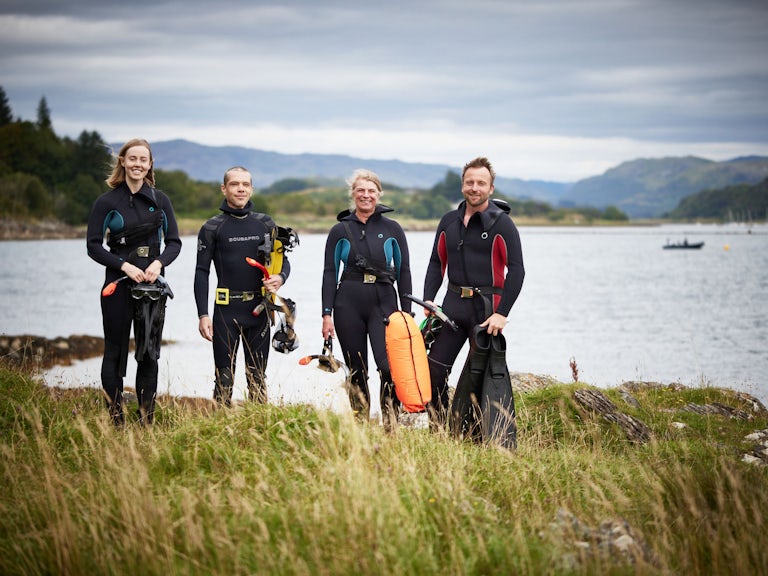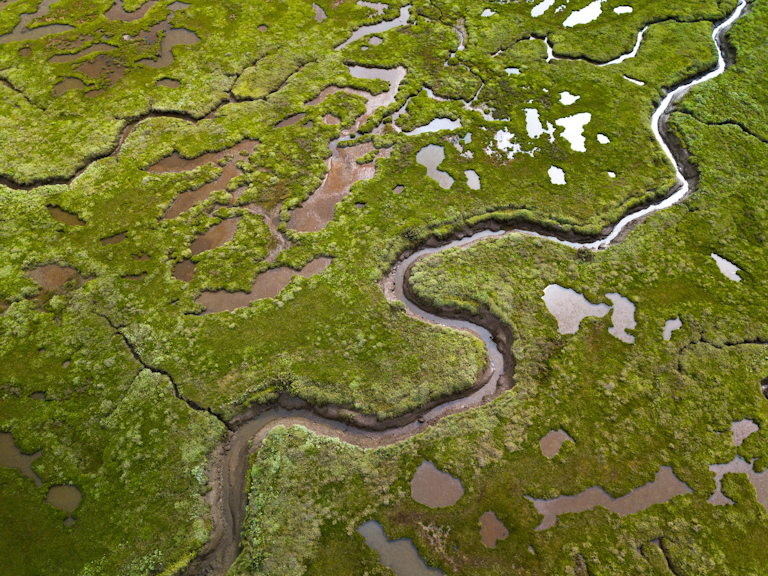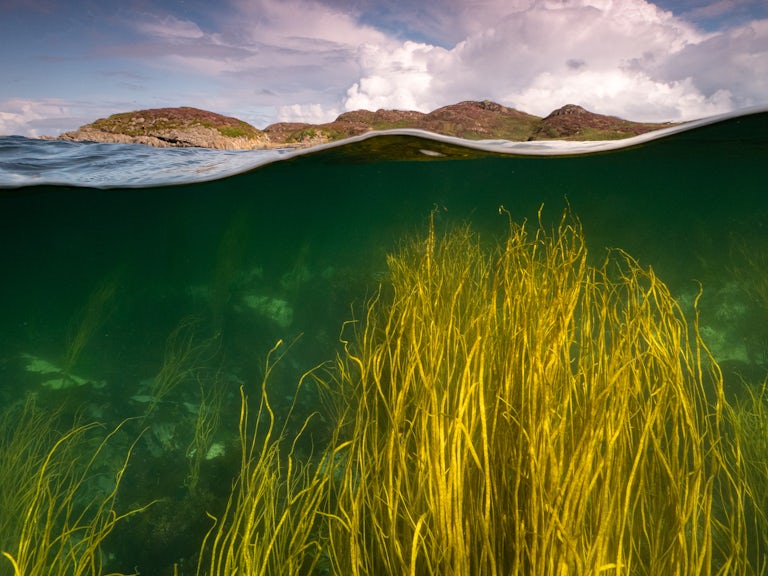Ten essential changes to scale up marine rewilding
Rewilding Britain Marine Rewilding Coordinator Jacques Villemot sets out how the new UK Government can support bold, ambitious policies to rewild our seas and restore coastal ecosystems. With these 10 changes, Britain could make significant strides in rewilding its marine ecosystems.

Published 09/08/2024
With a newly appointed UK Government, we have a unique opportunity to highlight the importance of a healthy marine environment. It’s time for our elected representatives to support bold and ambitious policies to rewild our seas and restore the health of our marine and coastal ecosystems.
At Rewilding Britain we’ve done the hard work for political leaders and created the 30% Rewilding Manifesto to enable the government to act swiftly and decisively to protect, restore and rewild nature in Britain. Here are the top 10 changes we believe are necessary to restore marine life and rewild our coastlines.
Support and enable community-led marine rewilding initiatives
Britain’s ecosystems are severely degraded, but restoring them is currently hindered by the complex process of obtaining government consent and securing funding for rewilding projects. Here’s how to unlock this.
Explore our Rewilding Manifesto
1: Fast-track marine rewilding projects with a streamlined licensing system
Marine rewilding projects have to go through the same licensing process as developments such as new oil rigs. Though necessary in principle, the current process is extremely complex to navigate, burdensome, costly, doesn’t consider the positive impacts of marine restoration and is a significant hurdle to launching new projects, especially community-led ones. We need to reform this system to reflect the needs and support the development of these rewilding projects.
2: Develop funding mechanisms to empower communities to restore coastal ecosystems
Unlocking funding to empower coastal communities to rewild their coastlines on a large scale is essential. This could be done through private funding initiatives such as marine net gain, an environmental management concept aimed at ensuring that marine development projects result in a net positive impact on marine ecosystems and biodiversity. However, appropriate safeguards must be developed to avoid greenwashing.

Case study: Seawilding
Seawilding is the UK’s first community-led oyster and seagrass restoration project. It aims to restore lost biodiversity, sequester carbon, create green jobs and mentor other community-based groups in doing the same. Numerous awards bestowed upon them highlight their impressive achievements. By restoring 350,000 native oysters and planting 300,000 seagrass seeds, Seawilding has demonstrated the important role of community-led initiatives in restoring our coastlines.
Learn more about the project
Deliver truly protected marine areas
Even though 38% of UK seas are officially protected, these areas aren’t given the chance to recover and help address the nature and climate emergencies [1]. The framework for protection must be updated so that Marine Protected Areas (MPAs) can play a role in the large-scale rewilding of our seas.
3: Embrace a whole-site approach to Marine Protected Areas
Today, MPAs only afford protection to specific species. Damaging activities and developments, such as dredging, drilling for oil or gas, and bottom trawling, are still taking place within their boundaries, overlooking the interconnected nature of the marine environment. This approach doesn’t support the large-scale rewilding of our seas, nor does it allow these sites to play a key role in enabling the wider recovery of our marine environment.
A holistic approach to managing these areas will maximise benefits for marine life and those depending on it, such as coastal communities and the fishing industry. That’s why, at a recent workshop we hosted with various marine organisations and members of the Rewilding Network, we looked to develop tools to support a whole-site approach for MPA management.
4: Ban bottom trawling in Marine Protected Areas and better regulate it outside these areas
Bottom trawling, a fishing method that involves dragging weighted nets across the seabed, is highly destructive for the seabed and the species relying on it. Yet, believe it or not, this practice still takes place in most MPAs. For these areas to be truly considered havens for nature, this damaging practice must be better regulated and banned from all sites designated to safeguard biodiversity.
5: Designate new Marine Protected Areas to support blue carbon capture and storage
It’s often overlooked that the ocean is a vital ally in tackling climate change, acting as a buffer that protects our atmosphere from its full effects. So far, the ocean has captured 90% of the excess heat generated by CO2 emissions and continues to capture and lock away carbon in its sediments — known as ‘blue carbon’.
Yet, marine ecosystems that store blue carbon remain largely unprotected in the UK. No MPAs have been designated specifically for the protection they can bring against climate change, leaving some blue carbon hotspots vulnerable to damage and the potential re-release of stored carbon in the atmosphere. Protecting these blue carbon hotspots is critical to ensure our seas continue to play their part in the greatest challenge of our time.
6: Establish 10% of the MPA network as core rewilding areas
Core rewilding areas focus on restoring and reinstating as wide a range of natural processes, habitats and missing species as possible. Such areas would provide much stricter protection to marine ecosystems, removing all pressures and allowing them to become the gold standard for marine rewilding and nature-led recovery in UK seas. Strict protection has consistently been proven to be the most effective way to restore marine ecosystems, yet less than 1% of UK seas currently meet these standards.

Case study: Community of Arran Seabed Trust
The pioneering Community of Arran Seabed Trust (COAST) was founded to stand against the destructive fishing practices near the Isle of Arran. In 2008, COAST established the first community-led No Take Zone (NTZ) in Lamlash Bay. This was followed by the designation of a larger Marine Protected Area around the NTZ to regulate scallop dredging, while allowing more sustainable practices in certain areas. Today, species populations within the NTZ are recovering and the area is closely monitored and studied.
Manage harmful activities to protect climate and nature
If we are to tackle climate change and reverse environmental degradation, managing harmful activities is crucial for safeguarding our planet’s future. We need innovative strategies to mitigate the negative impacts on our oceans.
7: Develop and deliver a climate-smart fisheries strategy
In 2016, global fishing fleets released as much CO2 into the atmosphere as 51 coal-fired power plants [2]. Some fishing methods, particularly bottom trawling, have recently been shown to damage blue carbon stocks in the seabed, resulting in the re-release of 370 million metric tons of CO2 each year [3]. It’s time for decision-makers to support the transition to sustainable fishing practices and infrastructures that are better aligned with our climate needs. This means enabling the electrification of the fishing fleet and incentivising small-scale, community-led fisheries over industrial practices.
8: Shift towards community-led, low-impact nearshore fishing practices
Nearshore marine habitats are vital in supporting broader marine biodiversity. They act as nurseries and provide shelter for many species, including commercially significant ones. It’s also where kelp and seagrass habitats — particularly effective in capturing carbon and protecting us against the effects of climate change — thrive. The new government and relevant bodies across the nations need to support the expansion of byelaws regulating damaging fishing practices nearshore. This can only be done in collaboration with coastal communities, ensuring they’re provided alternatives for a just transition where needed.
9: Improve water quality
The figures highlighting the extent of the sewage overflow scandal across the UK remain consistently high year after year. Not only does this pose a serious health risk to water users, it’s also a severe threat to the marine environment. Sewage pollution causes the eutrophication of our seas, harming key ecosystems such as seagrass meadows. Recent reports have highlighted that pollution can cause carbon-storing seagrass meadows to become carbon emitters [4]. The first step to address this issue is to increase monitoring of combined sewage overflows and agricultural pollution, which can leach nitrogen, pesticides and other chemicals into our rivers. In turn, this will enable the appropriate enforcement of the existing legislation.
10: Reform marine spatial planning to be truly ecosystem-based
The Marine Spatial Planning (MSP) framework exists to spatially organise activities and developments across our seas. Although it was designed to leave enough space for nature to recover and thrive, it currently doesn’t deliver on this principle. To meet net-zero targets and give nature a chance to be wild and healthy, reforming the MSP framework is more important than ever, especially given the extensive industrialisation of our seas.

Case study: Sussex Bay
The Sussex Bay project aims to connect organisations, businesses and individuals along the coastline to restore biodiversity while delivering economic and social benefits to local communities. Working at seascape level, it delivers a global vision by connecting marine ecosystems and integrating terrestrial projects. Funding from Rewilding Britain, awarded as part of our annual £100K Rewilding Challenge Fund, will enable Sussex Bay to accelerate its ambitions into 2025, boosting the nature-led recovery of marine habitats and creating opportunities for community engagement, employment, education and circular economy projects.
With the new government poised to shape the future of Britain’s marine and coastal environments, now is the time to Think Big and Act Wild. By implementing these 10 crucial actions, we can drive significant progress in rewilding our seas and restoring coastal ecosystems.
Sign the petition
Join over 18,000 others and sign our petition to bring the Rewilding Manifesto to the attention of the government.
- JNCC - Adviser to Government on Nature Conservation. (2023). UK Marine Protected Area network statistics.
- Greer, K., Zeller, D., Woroniak, J., Coulter, A., Winchester, M., Palomares, M. D., & Pauly, D. (2019). Global trends in carbon dioxide (CO2) emissions from fuel combustion in marine fisheries from 1950 to 2016. Marine Policy, 107, 103382.
- Atwood, T. B., Romanou, A., DeVries, T., Lerner, P. E., Mayorga, J. S., Bradley, D., Cabral, R. B., Schmidt, G. A., & Sala, E. (2024). Atmospheric CO2 emissions and ocean acidification from bottom-trawling. Frontiers in Marine Science, 10.
- Unsworth, RKF., McGarrigle, A., Fox, E., Millington-Drake, M., Perrin, E., Swithinbank, H., Harris, F., Thomsen, E., Jones, BLH., Watson, F., Wright, R. (2024). Seagrass vs Water Quality: How the current crisis is damaging our ability to fight climate change. Blue Marine Foundation, Project Seagrass and Surfers Against Sewage Collaborative Report.



